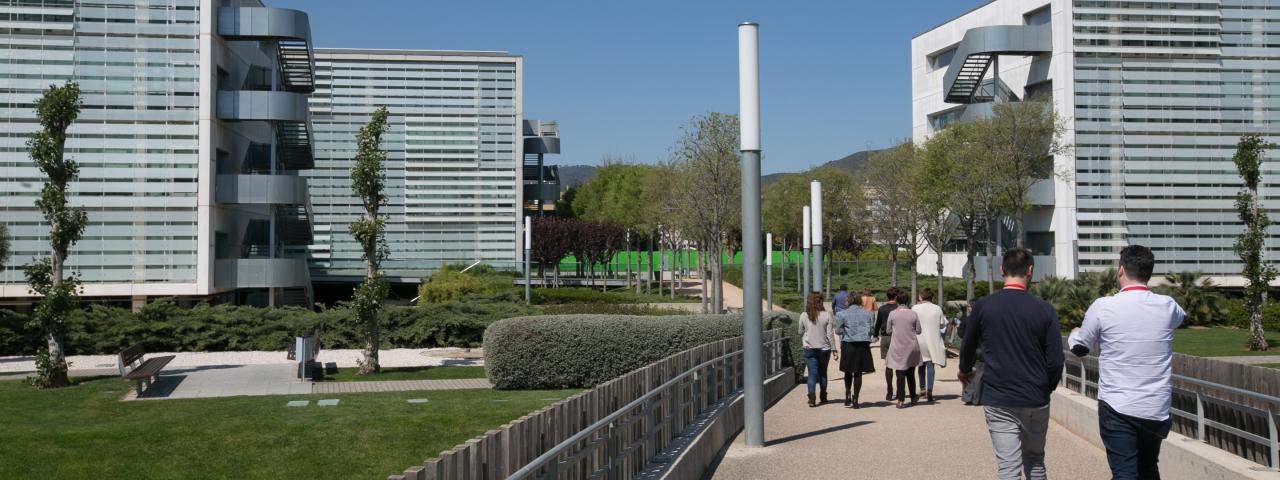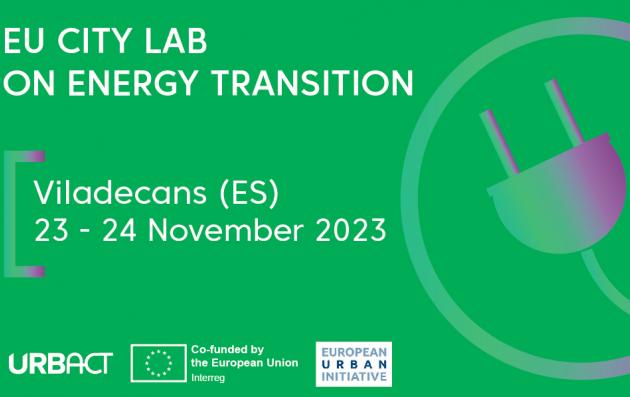
© Ajuntament de Viladecans
Discover Viladecans’ innovative governance for Energy Transition for smaller cities and beyond.
Consider this: currently, about 35% of the EU's buildings are over 50 years old. We are talking about Cold War times. The era of floppy disks, the first video game Pong, cell phones big as shoes, weighting a kilo or more. All that to say that buildings are responsible for 40% of EU energy consumption and 36% of CO2 emissions, with these older buildings consuming at least five times as much as new ones, and up to 60 litres of heating oil per year. By improving the energy efficiency of buildings, the EU total energy consumption can be reduced by 5-6% and CO2 emissions lowered by about 5%.[1]
Seems like big cities ought to be leading innovation here. After all, they have the highest concentration of buildings and CO2 emissions, right? Even though there is truth to this, for the city of Viladecans (ES) the issue is not just about innovation for energy efficiency. No matter the city’s size. It is about innovation in governance, about changing mindsets, and this is where mid-size cities like Viladecans can prove to be game changers in Europe, so the rest of the world can take note. The city is living proof of how small-scale social innovation works for achieving global goals.
Unavoidably, the European Commission's targeted ecological transition means that behavioural change must happen. Change in people and processes in the ecosystem of socio-political economics and in the ways suppliers, consumers and public players offer energy solutions. In this sense, integration is the participation and active involvement of the business sector, city administration institutions, schools, research centres, universities, and most of all citizens, in particular those feeling the economic squeeze of high energy costs. How to start? Such is Viladecans’ bold proposition called VILAWATT.
Conceived in 2016 with European funding as an Urban Innovative Action (UIA), VILAWATT is an innovative Public-Private-Citizen Partnership for energy governance at the local level, where the participative process involves both building owners and building designers. Its overall objective is to spark a shift in citizens’ thinking about energy, of empowering and motivating citizens to play an active role that leads to a profound change in attitudes and energy renovation processes. VILAWATT is made up of the Viladecans City Council, the Barcelona Metropolitan Area and two associations: The Citizen Association for Energy Transition & The Business and Retailers Association for Energy Transition.
VILAWATT and its Public-Private-Citizen Partnership is based on the idea that energy is not a luxury good, but a basic need. That the charge and responsability for local government is to ensure for citizens that innovation in energy autonomy and governance is based on openness, transparency and trust. Key allies are therefore people and users of energy and those in energy-poverty areas: key tools are awareness-raising and community work. For Viladecans, even though VILAWATT is technically a project applied to energy transition, its actions transcend the electricity grid and the energy market’s cost-benefit considerations. It is a social innovation generating self-reflection and pre-emptive measures in favour of higher efficiency and against energy divisions across society.
Here is some context about how the "local" became "glocal", thanks to a motivated and bold leadership that has driven such process. Viladecans, a city in the south of the Baix Llobregat county, is located near Barcelona and is part of the Barcelona Metropolitan Area. Densely populated with 67,197 inhabitants (2020) in a municipal area of just 20.4 km2, its urban development has been marked by the great waves of immigration and industrialisation of the 20th century — that of the 20’s and, then again in the 60’s and 70’s — which not only transformed a small agrarian town into an industrial and service city, but led to the construction of buildings in new and peripheral neighbourhoods.
Jordi Mazón, Deputy Mayor for ecological transition and leader of the VILAWATT project, frames the duality of the energy challenge for the city in the long-term: “Energy governance is part of the problem and part of the solution". But as Mazón recognises, “the greatest strength of VILAWATT Project has been to create a well-established structure, the PPCP Consortium, which manages energy differently and is leading to the change of the energy model. Viladecans is very well positioned to become a self-sufficient energy community and start the path to be carbon-neutral by 2050".
This carbon-neutral path shares a common direction with other goals in Viladecans, in Europe, and in the world. As a Covenant of Mayors signatory, Viladecans, with its Sustainable Energy Action Plan running since 2009 — updated to Sustainable Energy and Climate Action Plan, SECAP in 2017 — follows the objectives set by the United Nations and the European Commission’s Urban Agenda, and involves one of the city’s priority axes in Viladecans’ 2030 strategy - Ecological Transition, along with Innovation in Education, City Resilience, and Quality of Life.
Now, Viladecans has also lead the ambitious VILAWATT Transfer Mechanism pilot. This network has ran from March 2021 to September 2022, seeking to transferr the knowledge it has aquired over four years with UIA, to the cities of Seraing (BE), Nagykanizsa (HU) and Trikala (EL).
Funded by the URBACT III Programme, this network aimed to help local governments to drive their energy transition process by the creation of an innovative governance structure — the local public-private-citizen partnership — providing four key services to improve energy management at the local level: energy supply, energy culture, retrofitting of buildings and a local crypto currency linked to energy savings.
Seraing, Nagykanizsa and Trikala are all small to medium cities like Viladecans with ambitious energy strategic plans. All are also signatories of the Covenant of Mayors and are working on their own Plans for Sustainable Energy and Climate for re-orienting their economies towards becoming smarter, more energy efficient, and circular. All are keen to be leaders in their regions, making their cities’ become healthier and greener, exactly what VILAWATT seeks to happen.
For Mazón and fellow VILAWATT pioneers, the initiative is about joining forces in each city to find a way ahead that works, given the disparate local situations each city faces, and borrowing practices that have been successful in partner cities. As he put it, “innovating methods for us is also rethinking what is being done and combining it with new ideas and trends”. Because cities are where most people live, after all, almost 75% of the European population live in urban environments. This has made cities like the ones involved in this network an ideal innovation testing ground at many levels.
Cities can change the frame through which a common problem is viewed. Cities can be testbeds, they can set objective, regulators, and assessors of the incentive costs for changing the status quo. They can also be, in the case of the VILAWATT network, change leaders for citizen-backed, co-designed actions for the city’s just and sustainable transformation to become carbon neutral. The network proposed to partners -- and still invites EU cities to this date -- to find win-wins with a project in which neighbours improve housing conditions making them more energy efficient, access green energy and get more affordable and transparent energy bills. This helps boost living conditions, while at the same time citizens receive training, are more aware of the energy efficiency, conscious of the energy consumption. It also generated employment.
For this, VILAWATT has launched several learning communities and offers specific training in the fields of energy efficiency and renewable energies, involving schools, retail sector, companies, unemployed. For example, ithe partner cities are using “gamification” to help people understand the technical aspects of the initiative, targeting demo-building communities willing to undergo the retrofitting and address energy poverty. While offering incentives to companies to join the currency circuit and benefit from its use, including free energy audits to retailers.
VILAWATT is transformational, not only in terms of its proposed holistic energy transition, but in governance. It is not about creating another bureaucratic layer but about finding ways to integrate the city’s different policies and enabling ways of mobilising the participation of citizens, creating social capital and making the city richer in what matters – healthier, greener lives, leaving nobody behind.
The cities in the VILAWATT network acknowledged that the project can serve as a driver to develop their long-term energy transition processes and demonstrate their alignment and solidarity, from a political view, with achieving UN SDGs and CO2 emissions reductions. The sustainability of these actions was one of the key targets for participants. These, coupled with the Directive on common rules for the internal electricity market (EU 2019/944) that led to the creation of Energy Communities, played a key role in the future of the cities and impacted on the development of each partner city’s respective projects.
Certainly, given the levels of required investments, each city has to find ways to support and encourage owners to engage in undertaking retrofitting measures. While regulations remain at the EU and national/state level, the deep transformations happen at the grassroot community level and these can only be realised in the cities. The timing is right, over the next 7 years, momentum-building mechanisms like Europe’s Next Generation and European Green Deal are ideal for cities like Viladecans and cities that share similar ambitions, so as to maximise their social capital, political will and social innovation capacities to advance their energy transition aims.
In preparation for the post-VILAWATT network, each involved city is prepared investment plans, containing each city’s value proposition for different stakeholders and for use in making the project’s innovative practice sustainable in its own municipality. For Viladecans, the challenge was to draw on the valuable two-way flows of knowledge sharing and feedback, while improving its own original citywide energy strategy and related activities. Viladecans has, for instance, experimented with new ways to engage with different groups and has tested the set up of sharing and learning communities.
VILAWATT and Viladecans' ideas and social innovation are emblematic of an emerging political vision, like Mazón said, gaining traction across Europe. It not only brings a glocal approach to this project, but a humanistic one. Mazón puts it best: “The most amazing materials currently being developed - the ones that are changing fields such as urban planning, engineering, and measurement, transforming our way of life in a radical way - are based on nanoscience”. He explains: “These innovative materials are based on manipulating atom by atom and putting them in optimal positions, to achieve a better material. The macroscopic properties of a material are the result of an optimal microscopic structure.”
Fittingly, he concludes: “Likewise, small-scale innovation on a small/municipal scale must make it possible to build a better society and planet. Municipalities are what atoms are to materials, and politicians are the equivalent of nanoscience engineers. We aim to create a better planet by improving our municipalities".
Want to learn more from Viladecans and other inspiring cities on how to take the energy transition leap?
Register now to the EU City Lab, Viladecans 23 - 24 November 2023.
[1] UN Environment Programme’s International Resource Panel report: Resource Efficiency and Climate Change, 2020; and Emissions Gap Report 2019 , both cited in the COM(2020) 662: A Renovation Wave for Europe - greening our buildings, creating jobs, improving lives

